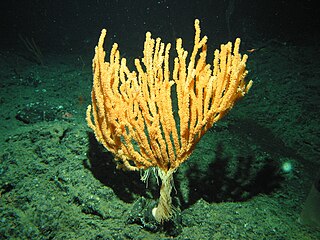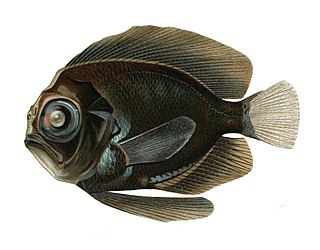
An island or isle is a piece of land, distinct from a continent, completely surrounded by water. There are continental islands, which were formed by being split from a continent by plate tectonics, and oceanic islands, which have never been part of a continent. Oceanic islands can be formed from volcanic activity, grow into atolls from coral reefs, and form from sediment along shorelines, creating barrier islands. River islands can also form from sediment and debris in rivers. Artificial islands are those made by humans, including small rocky outcroppings built out of lagoons and large-scale land reclamation projects used for development.

Sharks are a group of elasmobranch fish characterized by a cartilaginous skeleton, five to seven gill slits on the sides of the head, and pectoral fins that are not fused to the head. Modern sharks are classified within the clade Selachimorpha and are the sister group to the Batoidea. Some sources extend the term "shark" as an informal category including extinct members of Chondrichthyes with a shark-like morphology, such as hybodonts. Shark-like chondrichthyans such as Cladoselache and Doliodus first appeared in the Devonian Period, though some fossilized chondrichthyan-like scales are as old as the Late Ordovician. The earliest confirmed modern sharks (selachimorphs) are known from the Early Jurassic around 200 million years ago, with the oldest known member being Agaleus, though records of true sharks may extend back as far as the Permian.

Sylvia Alice Earle is an American marine biologist, oceanographer, explorer, author, and lecturer. She has been a National Geographic Explorer at Large since 1998. Earle was the first female chief scientist of the U.S. National Oceanic and Atmospheric Administration, and was named by Time Magazine as its first Hero for the Planet in 1998.

The footballfish form a family, Himantolophidae, of globose, deep-sea anglerfishes found in tropical and subtropical waters of the Atlantic, Indian, and Pacific Ocean. The family contains 23 species, all of which are classified in a single genus, Himantolophus.

The IMOCA, is a 60ft development class monohull sailing yacht governed by the International Monohull Open Class Association (IMOCA). The class pinnacle event are single or two person ocean races, such as the Route du Rhum and the Vendée Globe and this has been intimately linked to design development within the class. The class is recognised by World Sailing.

Conservation International (CI) is an American nonprofit environmental organization headquartered in Crystal City, Virginia, in Arlington County, Virginia.

Stomiidae is a family of deep-sea ray-finned fish, including the barbeled dragonfishes. They are quite small, usually around 15 cm, up to 26 cm. These fish are apex predators and have enormous jaws filled with fang-like teeth. They are also able to hinge the neurocranium and upper-jaw system, which leads to the opening of the jaw to more than 100 degrees. This ability allows them to consume extremely large prey, often 50% greater than their standard length.

Bamboo coral, family Keratoisididae is a family of coral of the phylum Cnidaria. It is a commonly recognized inhabitant of the deep sea, due to the clearly articulated skeletons of the species. Deep water coral species such as this are especially affected by the practice of bottom trawling. These organisms may be an important environmental indicator in the study of long term climate change, as some specimens of bamboo coral have been discovered that are 4,000 years old. Bamboo corals previously defined to be the family Isididae, based on their articulated skeletons with proteinaceous joints, but this family was shown to be paraphyletic after it was found in 2021 that this had evolved at least five separate times. As of 2023, the taxonomy of bamboo corals is being actively revised.

Photostomias is a genus of barbeled dragonfishes. They are found worldwide.

Caristius is a genus of manefishes native to the Atlantic and Pacific Oceans.
Neocaristius heemstrai is a species of fish in the family Caristiidae, the manefishes. It is native to the oceans of the southern hemisphere where it is known to occur at depths of from 420 to 1,360 metres. This species grows to a length of 11.8 centimetres (4.6 in) SL.

Platyberyx is a genus of manefishes native to the eastern Atlantic Ocean.
Photonectes paxtoni is a species of fish in the genus Photonectes. The species has been documented in the Pacific Ocean off the coast of Papua New Guinea, and adults can reach a maximum length of 2.3 centimeters.
Photonectes phyllopogon is a species of fish in the genus Photonectes. The species is rarely seen, but has been documented in the Atlantic and Indian oceans. Adults can reach a maximum size of ~10 centimeters.
Chauliodus barbatus is a species of deep-sea viperfish in the family Stomiidae. The species has been documented in the Pacific Ocean off the coast of Chile, and when full-grown, members of the species can reach a maximum length of ~19.8 centimeters.
Photostomias atrox is a species of barbeled dragonfish in the genus Photostomias. The species has been documented in the Atlantic and Pacific oceans, and fully-grown members of the species can reach a maximum length of ~15.4 centimeters.
Photostomias goodyeari is a species of barbeled dragonfish in the genus Photostomias. The species has been observed in the Atlantic Ocean, specifically in the Gulf of Mexico, and fully-grown members of the species can reach a maximum of ~17.5 centimeters in length.
Photostomias liemi is a species of rarely-seen barbeled dragonfish in the genus Photostomias. The species has been documented in the Pacific Ocean, and fully-grown members of the species can reach a maximum length of ~14.3 centimeters.
Photostomias lucigens is a species of barbeled dragonfish in the genus Photostomias. The species has been observed in the southern Pacific and Atlantic oceans, and fully-grown members of the species can reach a maximum length of 10.9 centimeters.











